Sustainable Tourism Development: Dolphin Discovery Centre Report
VerifiedAdded on 2021/06/16
|5
|1204
|25
Report
AI Summary
This report examines sustainable tourism practices at the Dolphin Discovery Centre, a non-profit tourism attraction in Australia. It addresses the environmental impact of tourism, particularly climate change, and its effects on marine life. The report analyzes key sustainability indicators such as water usage, energy consumption, and waste management, and the impact on job creation. It emphasizes the importance of proactive water management, the adoption of renewable energy sources, and effective waste management strategies to mitigate negative environmental impacts and ensure the long-term sustainability of the Dolphin Discovery Centre. The report concludes that achieving sustainable tourism requires the collaborative efforts of tourism operators and policymakers, focusing on environmental protection, economic viability, and community well-being.
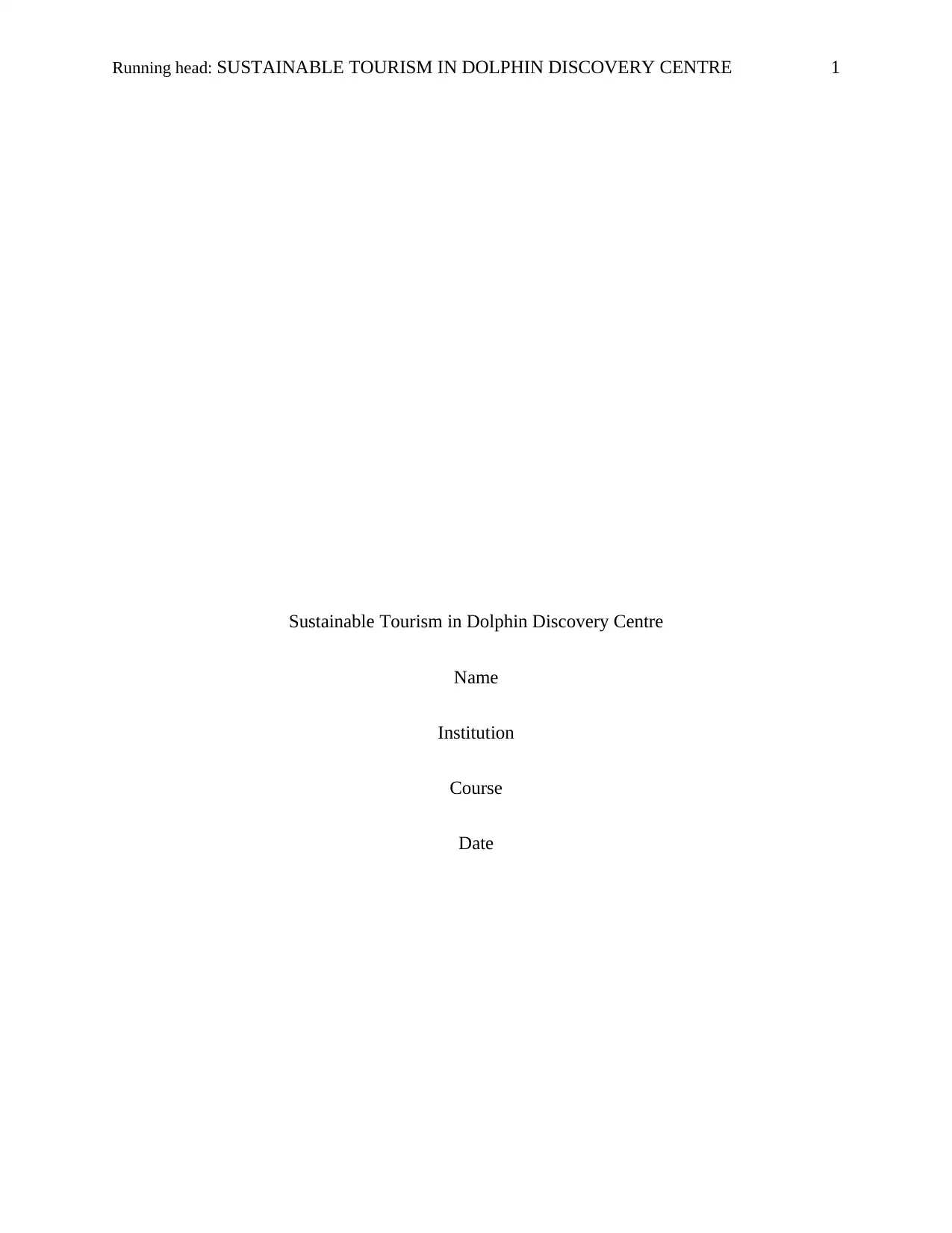
Running head: SUSTAINABLE TOURISM IN DOLPHIN DISCOVERY CENTRE 1
Sustainable Tourism in Dolphin Discovery Centre
Name
Institution
Course
Date
Sustainable Tourism in Dolphin Discovery Centre
Name
Institution
Course
Date
Paraphrase This Document
Need a fresh take? Get an instant paraphrase of this document with our AI Paraphraser
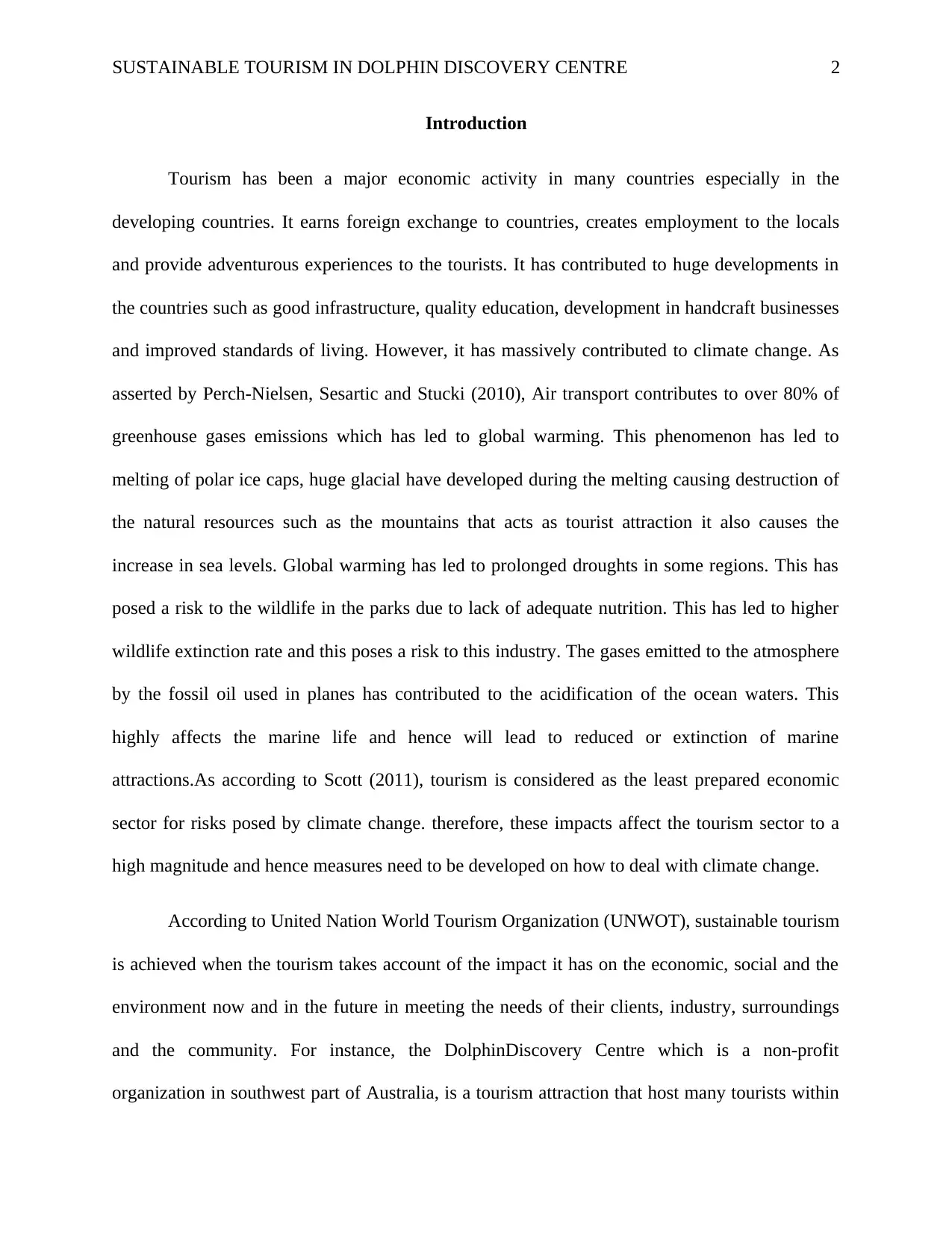
SUSTAINABLE TOURISM IN DOLPHIN DISCOVERY CENTRE 2
Introduction
Tourism has been a major economic activity in many countries especially in the
developing countries. It earns foreign exchange to countries, creates employment to the locals
and provide adventurous experiences to the tourists. It has contributed to huge developments in
the countries such as good infrastructure, quality education, development in handcraft businesses
and improved standards of living. However, it has massively contributed to climate change. As
asserted by Perch-Nielsen, Sesartic and Stucki (2010), Air transport contributes to over 80% of
greenhouse gases emissions which has led to global warming. This phenomenon has led to
melting of polar ice caps, huge glacial have developed during the melting causing destruction of
the natural resources such as the mountains that acts as tourist attraction it also causes the
increase in sea levels. Global warming has led to prolonged droughts in some regions. This has
posed a risk to the wildlife in the parks due to lack of adequate nutrition. This has led to higher
wildlife extinction rate and this poses a risk to this industry. The gases emitted to the atmosphere
by the fossil oil used in planes has contributed to the acidification of the ocean waters. This
highly affects the marine life and hence will lead to reduced or extinction of marine
attractions.As according to Scott (2011), tourism is considered as the least prepared economic
sector for risks posed by climate change. therefore, these impacts affect the tourism sector to a
high magnitude and hence measures need to be developed on how to deal with climate change.
According to United Nation World Tourism Organization (UNWOT), sustainable tourism
is achieved when the tourism takes account of the impact it has on the economic, social and the
environment now and in the future in meeting the needs of their clients, industry, surroundings
and the community. For instance, the DolphinDiscovery Centre which is a non-profit
organization in southwest part of Australia, is a tourism attraction that host many tourists within
Introduction
Tourism has been a major economic activity in many countries especially in the
developing countries. It earns foreign exchange to countries, creates employment to the locals
and provide adventurous experiences to the tourists. It has contributed to huge developments in
the countries such as good infrastructure, quality education, development in handcraft businesses
and improved standards of living. However, it has massively contributed to climate change. As
asserted by Perch-Nielsen, Sesartic and Stucki (2010), Air transport contributes to over 80% of
greenhouse gases emissions which has led to global warming. This phenomenon has led to
melting of polar ice caps, huge glacial have developed during the melting causing destruction of
the natural resources such as the mountains that acts as tourist attraction it also causes the
increase in sea levels. Global warming has led to prolonged droughts in some regions. This has
posed a risk to the wildlife in the parks due to lack of adequate nutrition. This has led to higher
wildlife extinction rate and this poses a risk to this industry. The gases emitted to the atmosphere
by the fossil oil used in planes has contributed to the acidification of the ocean waters. This
highly affects the marine life and hence will lead to reduced or extinction of marine
attractions.As according to Scott (2011), tourism is considered as the least prepared economic
sector for risks posed by climate change. therefore, these impacts affect the tourism sector to a
high magnitude and hence measures need to be developed on how to deal with climate change.
According to United Nation World Tourism Organization (UNWOT), sustainable tourism
is achieved when the tourism takes account of the impact it has on the economic, social and the
environment now and in the future in meeting the needs of their clients, industry, surroundings
and the community. For instance, the DolphinDiscovery Centre which is a non-profit
organization in southwest part of Australia, is a tourism attraction that host many tourists within
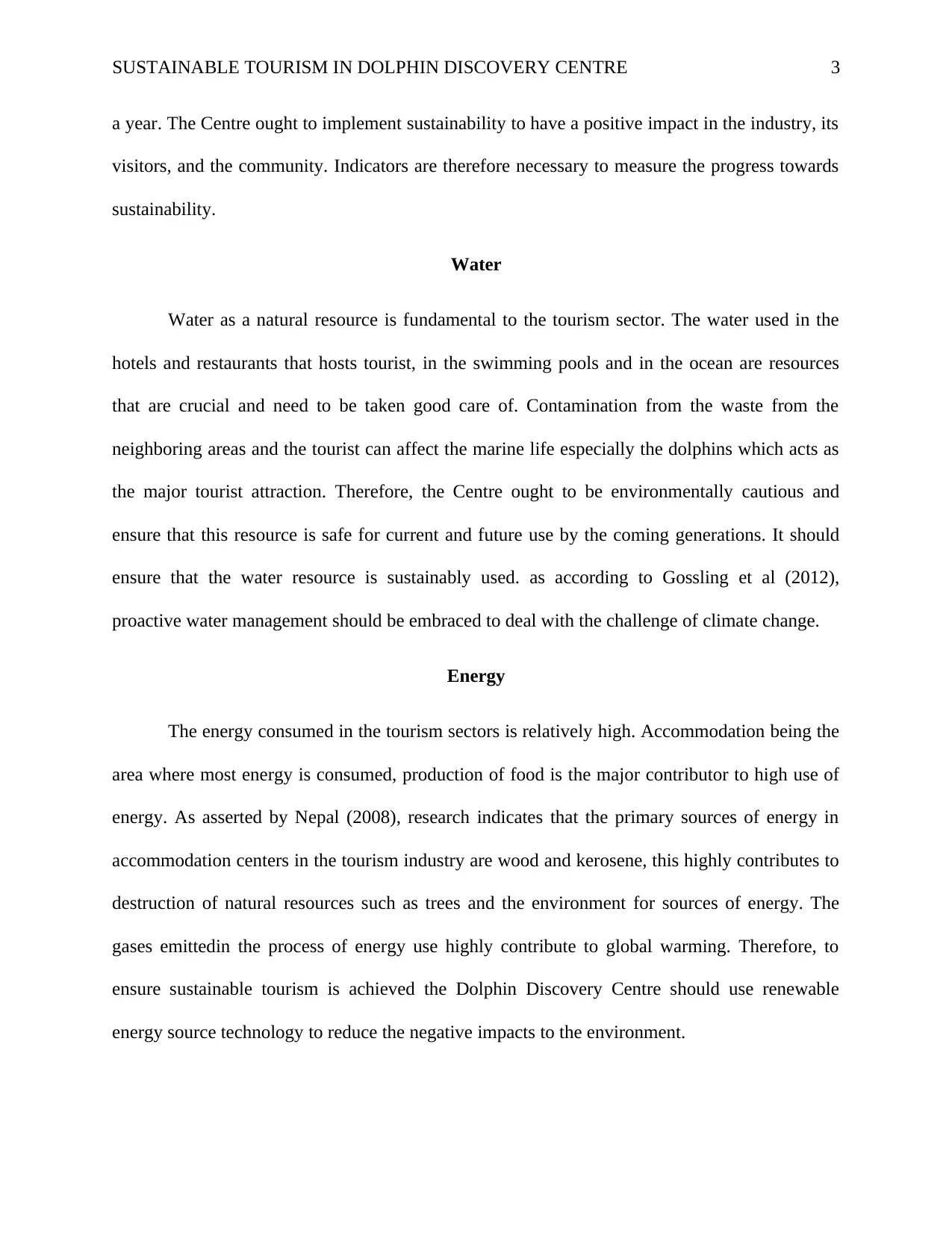
SUSTAINABLE TOURISM IN DOLPHIN DISCOVERY CENTRE 3
a year. The Centre ought to implement sustainability to have a positive impact in the industry, its
visitors, and the community. Indicators are therefore necessary to measure the progress towards
sustainability.
Water
Water as a natural resource is fundamental to the tourism sector. The water used in the
hotels and restaurants that hosts tourist, in the swimming pools and in the ocean are resources
that are crucial and need to be taken good care of. Contamination from the waste from the
neighboring areas and the tourist can affect the marine life especially the dolphins which acts as
the major tourist attraction. Therefore, the Centre ought to be environmentally cautious and
ensure that this resource is safe for current and future use by the coming generations. It should
ensure that the water resource is sustainably used. as according to Gossling et al (2012),
proactive water management should be embraced to deal with the challenge of climate change.
Energy
The energy consumed in the tourism sectors is relatively high. Accommodation being the
area where most energy is consumed, production of food is the major contributor to high use of
energy. As asserted by Nepal (2008), research indicates that the primary sources of energy in
accommodation centers in the tourism industry are wood and kerosene, this highly contributes to
destruction of natural resources such as trees and the environment for sources of energy. The
gases emittedin the process of energy use highly contribute to global warming. Therefore, to
ensure sustainable tourism is achieved the Dolphin Discovery Centre should use renewable
energy source technology to reduce the negative impacts to the environment.
a year. The Centre ought to implement sustainability to have a positive impact in the industry, its
visitors, and the community. Indicators are therefore necessary to measure the progress towards
sustainability.
Water
Water as a natural resource is fundamental to the tourism sector. The water used in the
hotels and restaurants that hosts tourist, in the swimming pools and in the ocean are resources
that are crucial and need to be taken good care of. Contamination from the waste from the
neighboring areas and the tourist can affect the marine life especially the dolphins which acts as
the major tourist attraction. Therefore, the Centre ought to be environmentally cautious and
ensure that this resource is safe for current and future use by the coming generations. It should
ensure that the water resource is sustainably used. as according to Gossling et al (2012),
proactive water management should be embraced to deal with the challenge of climate change.
Energy
The energy consumed in the tourism sectors is relatively high. Accommodation being the
area where most energy is consumed, production of food is the major contributor to high use of
energy. As asserted by Nepal (2008), research indicates that the primary sources of energy in
accommodation centers in the tourism industry are wood and kerosene, this highly contributes to
destruction of natural resources such as trees and the environment for sources of energy. The
gases emittedin the process of energy use highly contribute to global warming. Therefore, to
ensure sustainable tourism is achieved the Dolphin Discovery Centre should use renewable
energy source technology to reduce the negative impacts to the environment.
⊘ This is a preview!⊘
Do you want full access?
Subscribe today to unlock all pages.

Trusted by 1+ million students worldwide
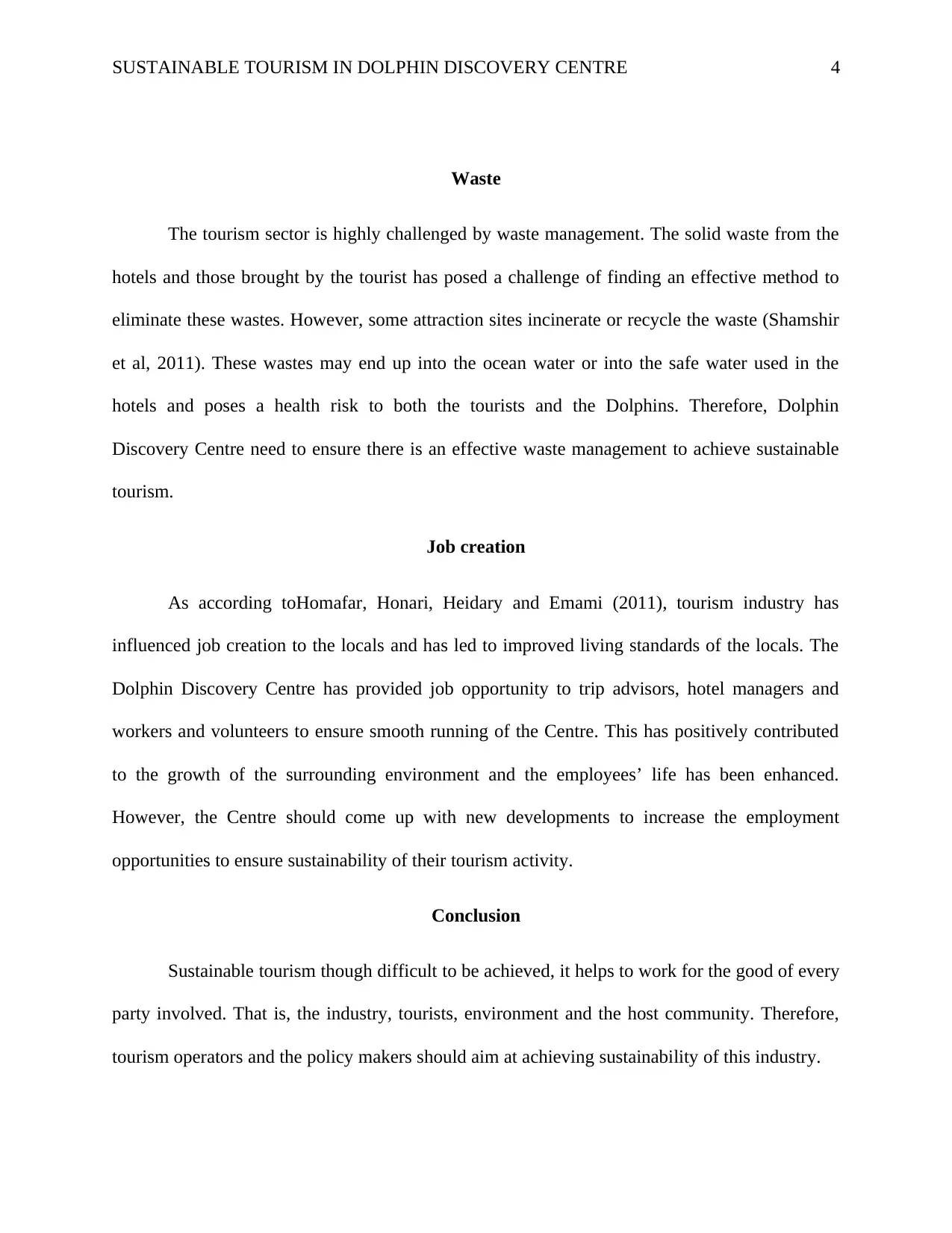
SUSTAINABLE TOURISM IN DOLPHIN DISCOVERY CENTRE 4
Waste
The tourism sector is highly challenged by waste management. The solid waste from the
hotels and those brought by the tourist has posed a challenge of finding an effective method to
eliminate these wastes. However, some attraction sites incinerate or recycle the waste (Shamshir
et al, 2011). These wastes may end up into the ocean water or into the safe water used in the
hotels and poses a health risk to both the tourists and the Dolphins. Therefore, Dolphin
Discovery Centre need to ensure there is an effective waste management to achieve sustainable
tourism.
Job creation
As according toHomafar, Honari, Heidary and Emami (2011), tourism industry has
influenced job creation to the locals and has led to improved living standards of the locals. The
Dolphin Discovery Centre has provided job opportunity to trip advisors, hotel managers and
workers and volunteers to ensure smooth running of the Centre. This has positively contributed
to the growth of the surrounding environment and the employees’ life has been enhanced.
However, the Centre should come up with new developments to increase the employment
opportunities to ensure sustainability of their tourism activity.
Conclusion
Sustainable tourism though difficult to be achieved, it helps to work for the good of every
party involved. That is, the industry, tourists, environment and the host community. Therefore,
tourism operators and the policy makers should aim at achieving sustainability of this industry.
Waste
The tourism sector is highly challenged by waste management. The solid waste from the
hotels and those brought by the tourist has posed a challenge of finding an effective method to
eliminate these wastes. However, some attraction sites incinerate or recycle the waste (Shamshir
et al, 2011). These wastes may end up into the ocean water or into the safe water used in the
hotels and poses a health risk to both the tourists and the Dolphins. Therefore, Dolphin
Discovery Centre need to ensure there is an effective waste management to achieve sustainable
tourism.
Job creation
As according toHomafar, Honari, Heidary and Emami (2011), tourism industry has
influenced job creation to the locals and has led to improved living standards of the locals. The
Dolphin Discovery Centre has provided job opportunity to trip advisors, hotel managers and
workers and volunteers to ensure smooth running of the Centre. This has positively contributed
to the growth of the surrounding environment and the employees’ life has been enhanced.
However, the Centre should come up with new developments to increase the employment
opportunities to ensure sustainability of their tourism activity.
Conclusion
Sustainable tourism though difficult to be achieved, it helps to work for the good of every
party involved. That is, the industry, tourists, environment and the host community. Therefore,
tourism operators and the policy makers should aim at achieving sustainability of this industry.
Paraphrase This Document
Need a fresh take? Get an instant paraphrase of this document with our AI Paraphraser
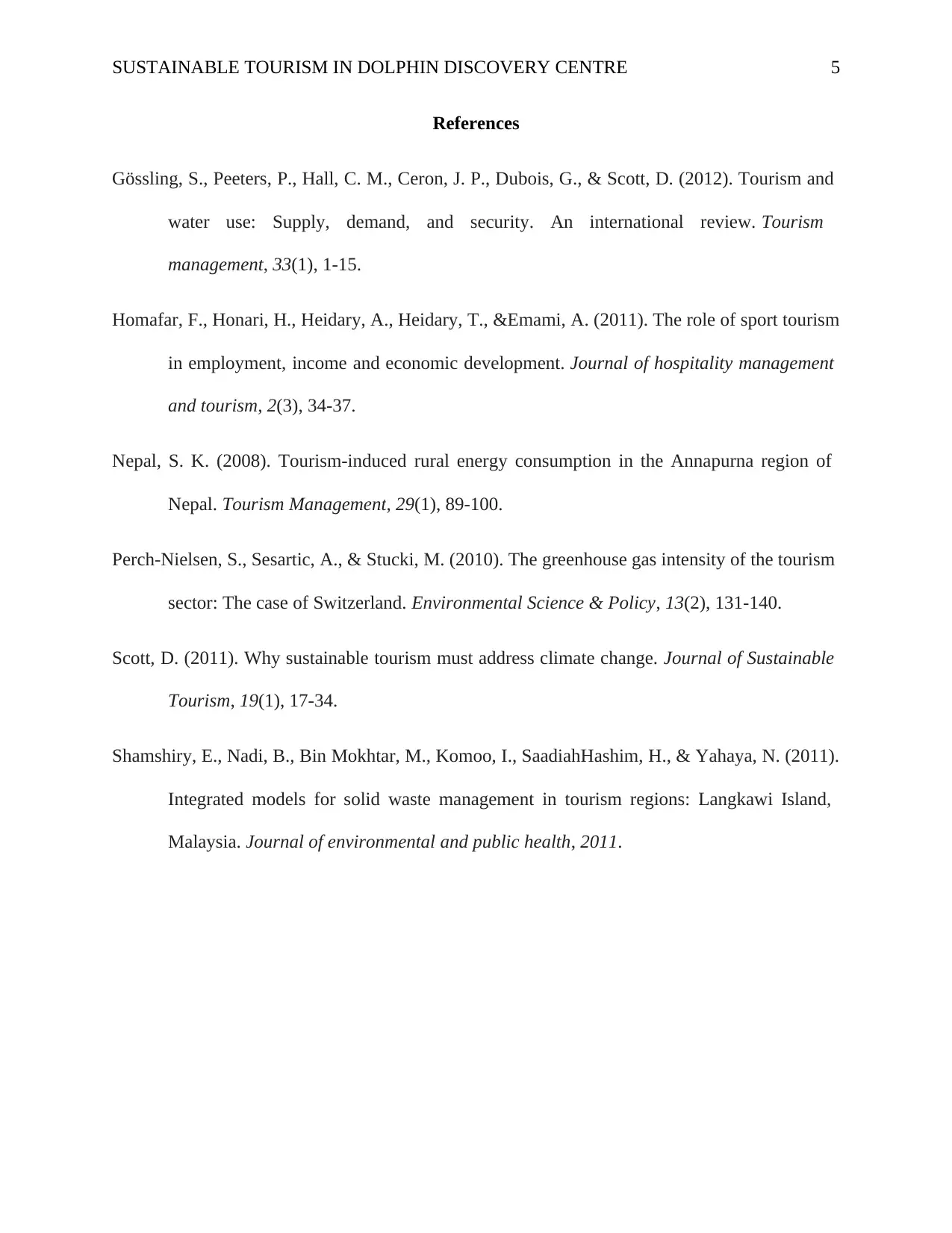
SUSTAINABLE TOURISM IN DOLPHIN DISCOVERY CENTRE 5
References
Gössling, S., Peeters, P., Hall, C. M., Ceron, J. P., Dubois, G., & Scott, D. (2012). Tourism and
water use: Supply, demand, and security. An international review. Tourism
management, 33(1), 1-15.
Homafar, F., Honari, H., Heidary, A., Heidary, T., &Emami, A. (2011). The role of sport tourism
in employment, income and economic development. Journal of hospitality management
and tourism, 2(3), 34-37.
Nepal, S. K. (2008). Tourism-induced rural energy consumption in the Annapurna region of
Nepal. Tourism Management, 29(1), 89-100.
Perch-Nielsen, S., Sesartic, A., & Stucki, M. (2010). The greenhouse gas intensity of the tourism
sector: The case of Switzerland. Environmental Science & Policy, 13(2), 131-140.
Scott, D. (2011). Why sustainable tourism must address climate change. Journal of Sustainable
Tourism, 19(1), 17-34.
Shamshiry, E., Nadi, B., Bin Mokhtar, M., Komoo, I., SaadiahHashim, H., & Yahaya, N. (2011).
Integrated models for solid waste management in tourism regions: Langkawi Island,
Malaysia. Journal of environmental and public health, 2011.
References
Gössling, S., Peeters, P., Hall, C. M., Ceron, J. P., Dubois, G., & Scott, D. (2012). Tourism and
water use: Supply, demand, and security. An international review. Tourism
management, 33(1), 1-15.
Homafar, F., Honari, H., Heidary, A., Heidary, T., &Emami, A. (2011). The role of sport tourism
in employment, income and economic development. Journal of hospitality management
and tourism, 2(3), 34-37.
Nepal, S. K. (2008). Tourism-induced rural energy consumption in the Annapurna region of
Nepal. Tourism Management, 29(1), 89-100.
Perch-Nielsen, S., Sesartic, A., & Stucki, M. (2010). The greenhouse gas intensity of the tourism
sector: The case of Switzerland. Environmental Science & Policy, 13(2), 131-140.
Scott, D. (2011). Why sustainable tourism must address climate change. Journal of Sustainable
Tourism, 19(1), 17-34.
Shamshiry, E., Nadi, B., Bin Mokhtar, M., Komoo, I., SaadiahHashim, H., & Yahaya, N. (2011).
Integrated models for solid waste management in tourism regions: Langkawi Island,
Malaysia. Journal of environmental and public health, 2011.
1 out of 5
Related Documents
Your All-in-One AI-Powered Toolkit for Academic Success.
+13062052269
info@desklib.com
Available 24*7 on WhatsApp / Email
![[object Object]](/_next/static/media/star-bottom.7253800d.svg)
Unlock your academic potential
Copyright © 2020–2025 A2Z Services. All Rights Reserved. Developed and managed by ZUCOL.




